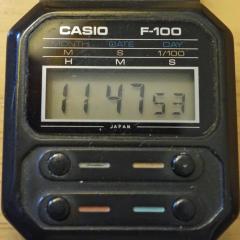Where to start troubleshooting?
-
Recently Browsing
- No registered users viewing this page.
-
Topics
-
Posts
-
This is the old/first(?) way for making a mainspring for an automatic. "Evolution-wise" it is an logical first step forward from a standard spring. Usually these are indeed replaced with a new spring with an integrated/fixed bridle. Lubrication as you would do with any automatic.
-
I'm working on a Schild AS 1250 (a 'bumper' automatic) and it's the first time I've seen a mainspring like this. It has what looks like a regular manual-wind mainspring with a 'hook' at its outer extremity. On a manual-wind watch that 'hook' would engage with a 'hook' in the barrel wall to prevent it from rotating. However, the AS 1250's mainspring does not engage directly with the barrel but rather with a 'sliding bridle' that sits between the mainspring and the barrel wall, and evidently facilitates the slip necessary in an automatic. I'm not sure what advantage this two-piece configuration provides, but it highlights a gap (one of many) in my horological knowledge. I'm not sure if 'hook' is the correct term as used above, but please see photo below to see what I mean. Therefore, two questions please. 1. What is the proper way to lubricate a barrel from an automatic watch with a sliding bridle? My guess is the same as any automatic ms/barrel (e.g, a few dabs of braking grease on the interior barrel wall). What do the experts say? 2. I purchased a Generale Ressorts GR3472X mainspring, made for the AS 1250. It looks like the bridle is included and I don't need to salvage and re-use the old one. Is this a safe assumption? Thanks for the advice. If you have any other wisdom you'd like to share about separate sliding mainspring bridles, I would be very interested. Cheers!
-
That’s a nice idea, But i’m committed to providing this site as a gift to the watch repair community as my thank you for my incredible life i’ve had in this business. Ive done well and unless my financial circumstances change then i’m more than happy to foot the bill. If circumstances do change then be assured that I will make an appeal. For now, I’m comfortable with the way things are and I am extremely delighted to remove Google Ads from this site and to stop Patreon, it feels like a major step forward 🙂 Sorry, I missed your reply, I got blinded by another poster in this thread. Yes - I can confirm that I have always seen WRT as a not-for-profit website, and therefore - not a business as such. I’m lucky and have done well in my life due to a decision made in my teens to start a watch repairing apprenticeship which has sustained myself and my family for many years now. Consider this my small way of paying it forward. Ive been committed to keeping the site alive on a technical and financial level for over 10 years now and I have zero plans to change that. Thank you for your kind words by the way. And as for your wish - nobody can control what happens in life, if something happens to me I have things in place with my family but I’m just not comfortable talking about my personal business - I wish a certain person would respect that, but i’ve calmed down now - i’m only human 😄
-




Recommended Posts
Join the conversation
You can post now and register later. If you have an account, sign in now to post with your account.
Note: Your post will require moderator approval before it will be visible.